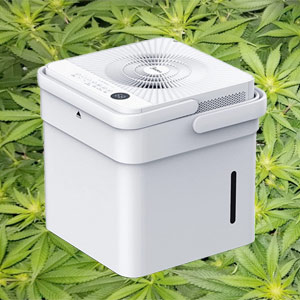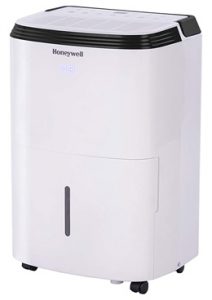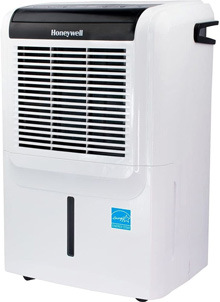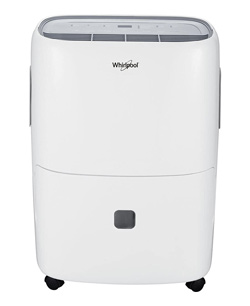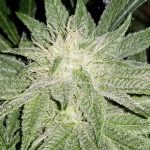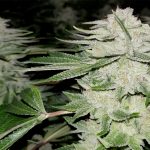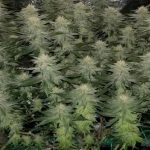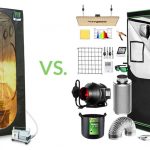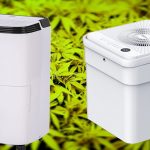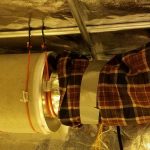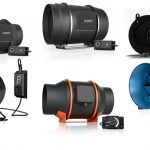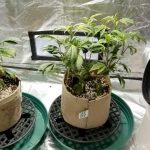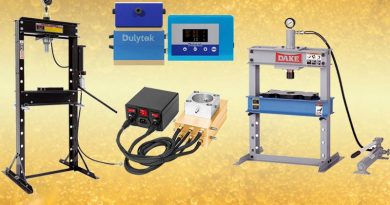Best dehumidifier for 4×4 grow tent
Find the best dehumidifier for 4×4 grow tent humidity issues and learn other ways to help control moisture when growing weed plants in a small tent.
We’ll help you figure out what size grow tent dehumidifier to buy, discuss features and options to consider, and outline the options of where to place dehumidifiers for best results.

These are the target humidity levels to aim for:
- Vegetative stage: 40%-60%
- Flowering stage: 40%-50%
- Last few weeks of flowering stage: 40% or less
What size dehumidifier for 4×4 grow tents?
The best dehumidifier for your 4×4 grow tent depends on the severity of your humidity issues and where you intend to place it.
Dehumidifiers used to come rated as 30 pint, 50 point, and 70 pint-per-day models. in 2019 the way they began testing them at a lower temperature, resulting in reduced moisture removal from the same devices. So they’re now labeled as 20 pint, 30 pint and 50 pint.
There are two places you can place your dehumidifier:
-
- Outside the tent (recommended): For most grow tent moisture problems or in damp climates, use a larger dehumidifier to dry out air in the “lung room” outside the tent which is introduced using an intake fan.
- Inside the tent: If your humidity problems are minor, a small dehumidifier can be placed directly inside the tent. This isn’t as efficient due to constant ventilation, and watch temperature levels carefully. If you’re supplementing CO2 in a sealed 4×4 grow tent, dehumidifiers will need to be much more powerful.
Creating a “lung room” outside the tent
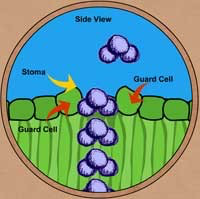
Unless you’re running a sealed tent while supplementing CO2, you’re better off placing the dehumidifier unit in the room outside the tent and creating a “lung room” with properly conditioned air.
Humidity levels can vary quite a bit inside 4×4 grow tents filled with bushy plants. It’s much easier to maintain the ideal humidity range outside the tent and circulate that air through it.
You will need to keep the air outside of your tent a bit drier than your tent’s target humidity level to offset moisture added by transpiration of your cannabis plants’ leaves. Nearly all the water you add ends up as transpired moisture.
So if you water 2.5 gallons of water each day, or 20 pints, then a dehumidifier for that size will work in fairly dry locations. Damper locations such as basements can require much more powerful units in the 50 pint per day range.
You want the air you pull in to be much drier than the air already in the tent. Increase air intake fans enough that you exchange tent air about once per minute. To quickly rectify an overly damp tent, point the exhaust fan on the dehumidifier right at your tent’s intake fan and crank it, forcing really dry air in.
Recommendations for the best dehumidifier for a 4×4 grow tent
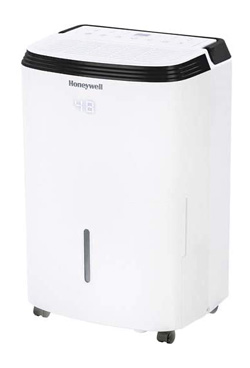
20-pint Honeywell dehumidifier ($200)
Best small dehumidifier for grow tents
The 20-pint Honeywell dehumidifier is a great choice for a cheap dehumidifier for 4×4 grow tents. They claim it is rated for 1000 square feet (although 400-500 SF is more reasonable for damp spaces) and can remove 20-30 pints of water per day depending on temperature.
This 20-pint model has a digital humidistat control, a drain tube, and a washable dust filter that doesn’t need to be replaced. It will auto-restart after a power outage which is a very important feature to consider when choosing a dehumidifier for 4×4 grow tents. It’s 10.5″ x 13.2″ x 20.1″ and weighs 14 pounds.
They also make an upgraded 20 pint Honeywell with wifi that lets you adjust humidity and fan speed settings via a remote app, which is great if you’re also using a wifi thermometer/hygrometer to monitor your grow tent remotely and need to make adjustments. The Honeywells are a bit more reliable than some of the cheaper competitor brands in the 20-pint size range.
 30 pint Honeywell dehumidifier ($259)
30 pint Honeywell dehumidifier ($259)
The 30 pint Honeywell ($259) is a better option to provide a bit more power in medium to large sized rooms.
It has a digital humidistat control system that automatically senses room moisture levels and activates dehumidification. It claims to be designed for spaces up to 3000 square feet, which is probably an overstatement.
We used this dehumidifier for years in a basement, but ended up sizing up to their 50-pint model with a pump. It’s always better to have a bit more drying power than you think you’ll need, so when in doubt size up. Otherwise you end up buying a bigger one down the line like we did.
50-pint Honeywell dehumidifier ($328)
If you’re growing weed in large rooms or damp basements you may want to opt for a higher-powered model such as Honeywell’s 50 pint dehumidifier.
50 pint models are good for growers who have multiple grow tents and need to offset the transpiration of moisture from more plants. They can remove about 6 gallons of water per day from the air and are ENERGY STAR rated. It has a 4.5 star rating on Amazon.
50 pint Honeywell smart dehumidifier ($332)
The 50 pint Honeywell smart dehumidifier is a similar unit that lets you adjust settings via a mobile app. Good for large damp areas or to control moisture from multiple grow tents.
50 pint Honeywell dehumidifier with pump ($328)
Best dehumidifier with pump
The 50 pint Honeywell with built in pump allows you to drain the tank into an elevated drain or window. Emptying buckets is no fun, so the built in pump option simplifies operation.
We have used this unit in a damp basement and highly recommend it.
It is very powerful and hasn’t had a problem discharging the water out an elevated basement window about 8 feet above. It says that it can pump as high as 15 feet. It auto-restarts after power outages which is a helpful feature for cannabis grows.
hOmeLabs 1,500 SF dehumidifier ($220)
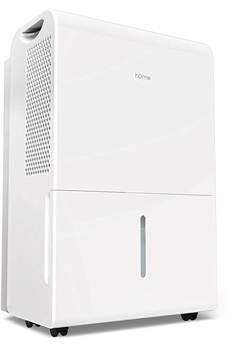 The hOmeLabs 1,500 SF Energy Star Dehumidifier is made for medium to large rooms and basements. It removes up to 22 pints of water per day (2.75 gallons) and is Energy-Star certified.
The hOmeLabs 1,500 SF Energy Star Dehumidifier is made for medium to large rooms and basements. It removes up to 22 pints of water per day (2.75 gallons) and is Energy-Star certified.
The water storage tank holds one gallon, and it will shut off automatically when full. Expect to have to empty it twice a day in damp situations. An optional drain hose attachment is included, which connects to a 5/8″ garden hose. Use teflon tape for a secure fit.
The unit is 15.2 x 10 x 19.7 inches and weighs 30.5 pounds.
hOmelab’s 1500 square foot model isn’t available with a pump, but pumps are available on their more powerful hOmelabs 50 pint dehumidifier. Their 50 pint model is meant for large spaces, such as big basements.
Whirlpool 40 Pint Portable Dehumidifier with pump ($230)
 Best cheap dehumidifier with pump
Best cheap dehumidifier with pump
The Whirlpool 40 Pint Portable Dehumidifier has a built-in pump so you’ll never have to empty a water tank. It is one of the smaller, most affordable models with the built-in pump option. The pump allows the unit to discharge water upward up to 16 feet to drain out a basement window or into a sink.
It is meant for a 500 square foot room. The digital humidity settings range can be set from 35% to 80%. There are 3 fan speeds and auto-defrost. According to Consumer Reports, the model WHAD40PCW has a tank size of 14.9 pints (1.86 gallons).
It has an easy to clean filter and will automatically restart if power goes out. It weighs 41.78 pounds and measures 12.01 x 15.04 x 25.2 inches.
Small dehumidifiers for inside 4×4 grow tents
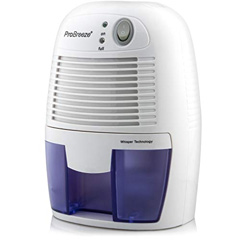
Placing a small dehumidifier inside a 4×4 tent seems like an obvious solution. Small tent, small dehumidifier.
But small units are not designed to remove enough moisture and small reservoirs fill up quickly. Emptying buckets sucks, and the unit shuts off until you do it.
Since exhaust fans should usually be exchanging grow tent air about 1x each minute, the minimal amount of drier air it produces is quickly pulled out. If ambient moisture levels rise in the room outside the tent small dehumidifiers can’t possibly keep up with plants’ transpiration rates.
We learned that lesson the hard way. Tiny dehumidifiers don’t do the job properly.
Recommendations for powerful small dehumidifiers placed inside grow tents
Midea Cube 20 Pint Dehumidifier with Smart Wi-Fi ($179)
Biggest tank size on a 20 pint dehumidifier
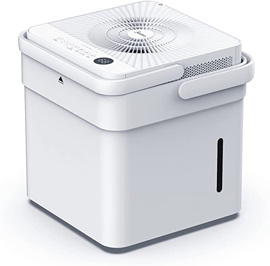 The Midea Cube 20 Pint Dehumidifier is a great cheap option that can be used inside grow tents. The Cube uses Wi-Fi so you can monitor and control it from your phone or via Alexa. The app has a full water tank alert, preset water tank levels, real-time water and humidity levels, and a predictive bucket fill algorithm.
The Midea Cube 20 Pint Dehumidifier is a great cheap option that can be used inside grow tents. The Cube uses Wi-Fi so you can monitor and control it from your phone or via Alexa. The app has a full water tank alert, preset water tank levels, real-time water and humidity levels, and a predictive bucket fill algorithm.
The Cube design is unique in that you can adjust the height. It has a no-bucket option that lets you remove the water tank and use the drain hose (included) to drain out of the tent to a floor drain.
In the nested setting it’s 13.5 x 13.5 x 13.39 inches, perfect when you need a powerful small dehumidifier inside a 4×4 grow tent under the plant canopy. When fully extended the bucket holds 3x more water. The air intake is multi-directional, a plus in grow tents. The digital controls let you adjust humidity from 35% to 85%.
Midea Cube 50 Pint Dehumidifier with Smart Wi-Fi ($258)
Largest water tank capacity
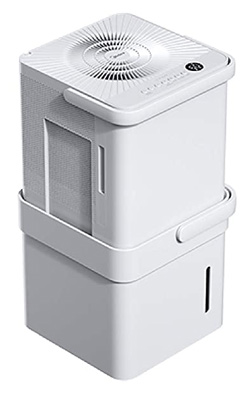 Midea’s 50 pint Cube is a powerful cheap humidifier for grow tents located in large, damp areas. It lets you set humidity levels between 35% to 85% and can be controlled using your phone.
Midea’s 50 pint Cube is a powerful cheap humidifier for grow tents located in large, damp areas. It lets you set humidity levels between 35% to 85% and can be controlled using your phone.
It is very compact, measuring 14.45 x 14.76 x 14.57 inches. The height can be extended to increase the bucket size to 4.2 gallons, much larger than competitor’s water tanks. But this dehumidifier weighs 42 pounds and you need to lift the main unit off of the bucket each time to empty it — much more work than competitors who use slide-out buckets. So it’s a bit of a trade-off.
There is also a no-bucket option that lets you place the unit above the sink using the included drain hose, or position it over a floor drain, near a window or door. This is the best use case for this dehumidifier, since you can run it in the compact state and you don’t need to lift it daily to empty the bucket.
They also make a 50 pint Cube with a built-in pump in case the gravity drain isn’t enough.
Haier 20 Pint Dehumidifier ($139)
Best cheap dehumidifier for grow tents
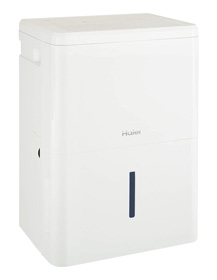 The Haier 20 Pint Dehumidifier model is the best cheap dehumidifier for 4×4 grow tent usage. It has enough power and a large enough tank to keep relative humidity (RH) levels down.
The Haier 20 Pint Dehumidifier model is the best cheap dehumidifier for 4×4 grow tent usage. It has enough power and a large enough tank to keep relative humidity (RH) levels down.
Haier’s Smart Dry feature compares the set humidity level with the actual humidity level and automatically adjusts the fan speed accordingly. This is helpful to alter airflow if you’re seeing a large humidity variance in your light and dark cycles. It’s also good if you need to place this unit directly in a tent.
The front-loading bucket has a large capacity of 1.8 gallons, with a 10-second alarm when it gets full (although good luck hearing it over the sound of your inline fans). There is a continuous drain option, you can attach a hose about halfway up the left side. This unit measures 9.8 x 13.4 x 19.3 inches.
Note that the 20-pint Haier is meant for moderately damp locations. For moist environments, consider their much more powerful 50-pint Haier outside your grow tent.
A word of warning about small dehumidifiers for grow tents
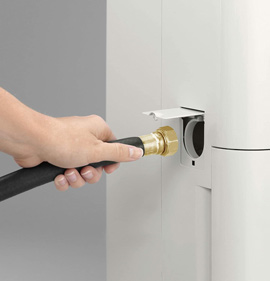
Be wary of online product descriptions for small dehumidifiers. Pay attention to how much water they can remove per day and tank size.
We learned the hard way that the small $100 units looked like they’d be perfect for a 4×4 tent only to find they couldn’t keep up. Smaller models usually lack a continuous drain option so they’ll shut off unless you constantly empty the small buckets.
Some small models run continuously until full, in which case you’ll need a humidity controller (such as Inkbird, $43) to turn them on/off as needed.
Placing a small dehumidifier in a grow tent isn’t going to solve most humidity problems. Make sure to buy a unit large enough to offset the amount of water you add to the plants each day, and factor in the humidity levels in the room around the tent since your dehumidifier will need to keep those in check too.
Inside the tent: dehumidifier placement tips
Dehumidifiers can go directly on grow tent floors, placed out of the way of potential issues with spilled water. Position it so the unit’s vents can circulate air, don’t put it in a corner with the intake flat against a tent wall. Don’t point the dehumidifier’s airflow directly at weed plants if you can avoid it.
Prop it slightly if you need to raise the height to facilitate water drainage through a hose. But try to keep it low.
Your tent’s exhaust system should be designed to intake fresh air from the bottom and exhaust warmer, humid air from the top. If it doesn’t, here’s how to correct it. Placing the dehumidifier low allows that dryer air to get pulled upward as the warmer humid air above is removed.
If you do place a dehumidifier inside your tent, make sure to cover any lights on the unit with black Gorilla tape.
Choosing the best dehumidifier features

When choosing a dehumidifier for your grow tent, there’s a few things to keep in mind.
- Dehumidifiers are rated by how many pints of water they are able to remove from the air. A 4×4 grow tent is only 12 square feet, a very small area. But if much of that space is filled with transpiring leaves, it can get humid quickly. Plants will transpire nearly all of the water you add each day.
- Small dehumidifiers have tiny reservoirs, so you may find yourself having to empty them often or they’ll shut off. Emptying buckets sucks. Larger models with bigger reservoirs reduce the chance it will shut off inadvertently.
- Look for models that allow you to attach drainage hoses to reduce this hassle.
- A dehumidifier with a pump will let you reach elevated drains.
- One of the best dehumidifier options for 4×4 grow tent usage is bluetooth connectivity so you can monitor and track levels on your phone.
- Look for models with multiple fan speeds and settings for target humidity level. Some cheaper models are designed to run continuously until full, while others can shut off when they reach a set level.
- Remember that the rating standards changed in 2019, resulting in the same units having a reduced rating due to testing occurring at lower temperatures. They’re not any less powerful. But the product descriptions can be confusing when they say dual ratings (such as 50 in one place, 70 in another). Always go for a slightly more powerful unit then you need, especially if you run it in basements cooler than 65 degrees.
Other ways to lower humidity in 4×4 grow tents
Below are a few things you should try to lower humidity in your grow tent. To learn more, check out how to lower humidity in a grow tent.
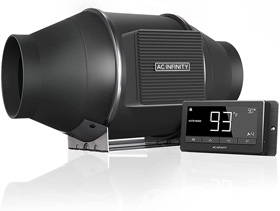
Increase your tent’s exhaust fan (and add a filtered intake fan if you don’t have one) to more quickly remove moist air. Use a humidity fan controller to turn the exhaust fan on as needed to keep things within suitable range. Learn more about grow tent ventilation setup and how to find the best fan for a grow tent.
For most tents this usually will be adequate to lower humidity levels. But for some growers the air outside their tent is too damp to control tent moisture levels and a dehumidifier is the solution.
If you don’t have an intake fan, you’ll need to turn up your exhaust fan and provide a way for fresh air to enter. When vegetating weed plants you can just open all of the lower flaps. In flowering you’ll need to seal those off to block light. At that point you can make a passive air intake vent using an 8 foot length of 6″ flexible ducting run through the lower vent port on your tent. Position it in a loop and away from light, which tends to reflect through the aluminum. Make an intake filter for the end.
A tip for new marijuana growers: try to fix grow tent humidity issues before the flowering phase begins. High humidity during mid and late flowering brings a big risk. Big, bushy plants transpire more moisture. You don’t want to watch your buds get moldy when they’re almost ready to go.
Need more info on picking a humidifier for a 4×4 grow tent? Check out our grow tent dehumidifier guide. For smaller tents, try our 3×3 grow tent dehumidifier guide.
If you are just getting started growing weed, see our complete instructions and tips to create the best possible environment for growing weed in our 4×4 grow tent setup guide.
